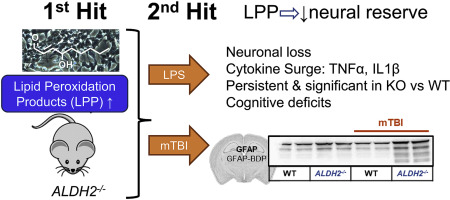Redox Biology ( IF 11.4 ) Pub Date : 2020-03-02 , DOI: 10.1016/j.redox.2020.101486 Rachel C Knopp 1 , Sue H Lee 1 , Michael Hollas 2 , Emily Nepomuceno 1 , David Gonzalez 1 , Kevin Tam 1 , Daniyal Aamir 1 , Yueting Wang 1 , Emily Pierce 1 , Manel BenAissa 2 , Gregory R J Thatcher 2

|
Oxidative stress induced by lipid peroxidation products (LPP) accompanies aging and has been hypothesized to exacerbate the secondary cascade in traumatic brain injury (TBI). Increased oxidative stress is a contributor to loss of neural reserve that defines the ability to maintain healthy cognitive function despite the accumulation of neuropathology. ALDH2−/− mice are unable to clear aldehyde LPP by mitochondrial aldehyde dehydrogenase-2 (Aldh2) detoxification and provide a model to study mild TBI (mTBI), therapeutic interventions, and underlying mechanisms. The ALDH2−/− mouse model presents with elevated LPP-mediated protein modification, lowered levels of PSD-95, PGC1-α, and SOD-1, and mild cognitive deficits from 4 months of age. LPP scavengers are neuroprotective in vitro and in ALDH2−/− mice restore cognitive performance. A single-hit, closed skull mTBI failed to elicit significant effects in WT mice; however, ALDH2−/− mice showed a significant inflammatory cytokine surge in the ipsilateral hemisphere 24 h post-mTBI, and increased GFAP cleavage, a biomarker for TBI. Known neuroprotective agents, were able to reverse the effects of mTBI. This new preclinical model of mTBI, incorporating significant perturbations in behavior, inflammation, and clinically relevant biomarkers, allows mechanistic study of the interaction of LPP and neurotrauma in loss of neural reserve.
中文翻译:

在轻度创伤性脑损伤的易处理模型中,ALDH2-/-小鼠中氧化应激和神经创伤的相互作用会引起显着且持续的行为和促炎作用。
脂质过氧化产物(LPP)引起的氧化应激会随着年龄的增长而发生,并且据推测会加剧颅脑外伤(TBI)中的次级级联反应。氧化应激增加是导致神经储备丧失的原因,尽管存在神经病理学积累,但神经储备定义了维持健康认知功能的能力。ALDH2 -/-小鼠无法通过线粒体醛脱氢酶2(Aldh2)的解毒作用清除醛LPP,无法为研究轻度TBI(mTBI),治疗干预措施和潜在机制提供模型。该ALDH2 - / -小鼠模型表现出升高的LPP介导的蛋白质修饰,降低的PSD-95,PGC1-α和SOD-1水平,以及从4个月大时开始出现轻度认知缺陷。LPP清除剂在体外具有神经保护作用,在ALDH2 -/-小鼠中可恢复认知能力。一次单次闭合颅骨mTBI未能在WT小鼠中引起明显的作用。但是,ALDH2 -/-小鼠在mTBI后24小时在同侧半球显示出明显的炎性细胞因子激增,并增加了TBI的生物标记物GFAP裂解。已知的神经保护剂能够逆转mTBI的作用。这种新的mTBI临床前模型结合了行为,炎症和临床相关生物标志物的显着扰动,可以对LPP和神经创伤在神经储备丧失中的相互作用进行机理研究。



























 京公网安备 11010802027423号
京公网安备 11010802027423号